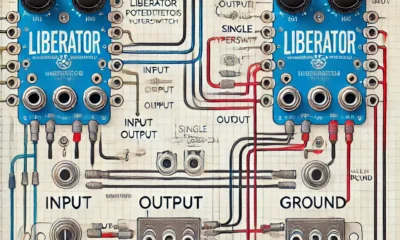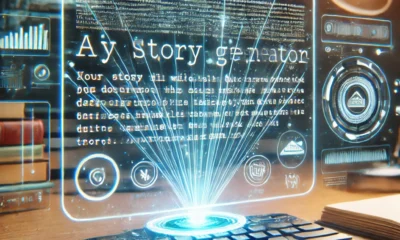Tech
How to Fix Error [ERR_HTTP_HEADERS_SENT]: Cannot Set Headers After They Are Sent to the Client
![[ERR_HTTP_HEADERS_SENT]: Cannot Set Headers After They Are Sent to the Client](https://techlable.com/wp-content/uploads/2025/01/DALL·E-2025-01-16-16.18.20-A-conceptual-illustration-of-the-Node.js-error-ERR_HTTP_HEADERS_SENT_-Cannot-Set-Headers-After-They-Are-Sent-to-the-Client.-The-image-shows-a-serv.webp)
Introduction
Handling HTTP errors in Node.js can be a challenging task, especially when dealing with the infamous [ERR_HTTP_HEADERS_SENT] error. If you’ve encountered the message “Cannot set headers after they are sent to the client,” you’re not alone. This error can be perplexing, but it is entirely fixable with a bit of knowledge and effort.
What Is the [ERR_HTTP_HEADERS_SENT] Error?
The [ERR_HTTP_HEADERS_SENT] error occurs when your server attempts to modify HTTP headers after they’ve already been sent to the client. Since headers are immutable once dispatched, any attempt to alter them triggers this error.
Why Does This Error Occur?
This error often arises due to improper response handling in your application. The most common culprits include asynchronous logic mishaps, calling response methods like res.send or res.end multiple times, or misconfigured middleware.
Common Causes of [ERR_HTTP_HEADERS_SENT]
Setting Headers Multiple Times
If you invoke res.send or res.json more than once in a request lifecycle, Node.js will throw the error because headers can only be sent once.
Asynchronous Code Mismanagement
Poor handling of asynchronous code, such as forgetting to add return statements or using nested callbacks, can inadvertently trigger multiple responses.
Middleware Execution Order
Misconfigured middleware can lead to this error if one middleware sends a response and another tries to modify headers afterward.
Using res.send and res.end Together
Calling both res.send and res.end in the same request causes conflicts, as both attempt to finalize the response.
Step-by-Step Guide to Fixing [ERR_HTTP_HEADERS_SENT]
Step 1: Understanding the Stack Trace
The error message typically includes a stack trace that points to the problematic line of code.
How to Read the Stack Trace
Focus on the first few lines that mention your application’s files and locate the corresponding line in your code.
Identifying the Root Cause
Check where the response methods like res.send or res.json are invoked. Ensure these are not called multiple times in the same request cycle.
Step 2: Avoid Multiple Response Calls
Using return Statements Properly
Adding a return statement immediately after a response method ensures the function terminates, preventing subsequent calls.
Ensuring Clean Code Practices
Review your code to eliminate redundant response calls or conditionally executed response methods.
Step 3: Managing Asynchronous Logic Correctly
Using Promises Effectively
Replace nested callbacks with Promises or async/await syntax for better control over asynchronous flow.
Avoiding Nested Callbacks
Flatten nested callbacks by breaking your code into modular, reusable functions.
Step 4: Debugging Middleware Issues
Checking Middleware Order
Ensure middleware that sends a response is placed before those that modify headers.
Handling Errors Gracefully in Middleware
Incorporate robust error-handling middleware to catch and manage exceptions efficiently.
Step 5: Validating res Methods
Avoid Combining res.send, res.end, or res.json
Stick to one response method per request to avoid conflicts.
Best Practices to Prevent [ERR_HTTP_HEADERS_SENT]
- Write Modular Code: Break your application into smaller, reusable modules.
- Use Error-Handling Middleware: Centralize error handling to prevent conflicting responses.
- Implement Logging for Debugging: Use logging libraries like winston or pino to track issues.
- Test Edge Cases in Your Application: Validate your application against unusual user inputs and scenarios.
Real-Life Example and Fix
Example Scenario
Imagine an endpoint where a response is sent conditionally but lacks a return statement, causing multiple responses.
Applying the Fix
Add a return statement after each response to ensure no further execution occurs.
Tools for Debugging HTTP Errors
- Using Node.js Debugger: Leverage built-in debugging features to inspect your code.
- Leveraging IDE Debugging Features: Modern IDEs provide intuitive debugging tools.
- Exploring External Debugging Tools: Tools like Postman can simulate requests and highlight errors.
When to Seek Professional Help
Indicators You Might Need Assistance
- Persistent errors despite troubleshooting.
- Complex application architectures.
Finding the Right Support
Look for experienced Node.js developers or consult professional services for code review.
Conclusion
Key Takeaways
Fixing the [ERR_HTTP_HEADERS_SENT] error requires understanding response flow and maintaining clean, modular code.
Final Thoughts
By following these steps and adopting best practices, you can ensure a smoother development process and avoid similar issues in the future.
FAQs
What is the quickest way to identify [ERR_HTTP_HEADERS_SENT]?
Check the stack trace in the error log to locate the problematic code.
Can this error occur in front-end applications?
No, this error is specific to server-side code.
How does middleware contribute to this issue?
Middleware can trigger the error if response methods are mishandled or misordered.
What is the difference between res.send and res.end?
res.send sends the response body, while res.end finalizes the response without content.
Are there tools to automate debugging of HTTP errors?
Yes, tools like Postman and IDE debugging features can help automate the process.
Tech
DCUO Futuristoc Drone: Mastering Game-Changing Gadget

What Is the Futuristic Drone?
Imagine having a loyal robotic sidekick that shoots lasers, heals allies, and tanks damage—all while looking like it’s straight out of a sci-fi blockbuster. That’s the Futuristic Drone in a nutshell. Introduced in DCUO’s 2022 update, this gadget quickly became a fan favorite for its versatility.
A Brief History of Drones in DCUO
Drones aren’t new to DCUO. Earlier versions, like the Combat Robot and Shield Drone, were useful but limited. The Futuristic Drone, however, is the Tesla Cybertruck of gadgets—sleek, powerful, and packed with surprises.
Why the Futuristic Drone Stands Out
Unlike older models, this drone adapts to your playstyle. Are you a damage dealer? It’ll rain fire on enemies. Playing support? It’ll throw up shields and heal teammates. It’s like having a Swiss Army knife that flies.
Key Features of the Futuristic Drone
Let’s break down what makes this gadget a must-have.
Offensive Capabilities
Energy Blasts and Targeting Systems
The drone’s primary attack fires rapid energy blasts, perfect for whittling down bosses or clearing mobs. Its auto-targeting system ensures you never miss—even if your aim is as shaky as a caffeine-addicted squirrel.
Crowd Control Abilities
Stun grenades, slow fields, and knockback pulses? Check. The drone can lock down entire groups, giving you breathing room in chaotic fights.
Defensive Functions
Shield Generators
Deploy a temporary force field that absorbs 30% of incoming damage. Pair this with a healer, and you’ll feel invincible.
Healing Modules
In support mode, the drone releases nanobots that repair allies’ armor. It’s like having a medic on standby 24/7.
Customization Options
Tweak the drone’s appearance, prioritize attacks, or focus on defense. You can even rename it—how about “Robo-Buddy” or “Death From Above”?
How to Unlock the Futuristic Drone
Mission Requirements
Complete the “Tech Supremacy” storyline in the Brainiac’s Ship episode. Yes, it’s grindy, but worth it.
In-Game Currency and Vendors
After the mission, purchase the blueprint for 50,000 Marks of Victory. Pro tip: Farm daily missions to speed this up.
Event-Exclusive Upgrades
During seasonal events like “Future Tech Week,” you can snag rare mods to boost your drone’s stats.
Mastering Combat with the Drone
Solo Play Strategies
Set the drone to “Aggressive Mode” and let it tank enemies while you pick them off. Works wonders in open-world PvE.
Team Synergy in Raids
Coordinate with your squad:
- Healers: Set the drone to support.
- Tanks: Use its shields to mitigate boss attacks.
Upgrading Your Drone
Essential Mods and Enhancements
- Plasma Overclocker: +15% damage.
- Nano-Repair Core: Improves healing efficiency.
Farming for Upgrade Materials
Run the Cybernetic Warfare raid weekly for alloy drops.
Comparing the Futuristic Drone to Other Gadgets
Drones vs. Turrets
Turrets deal more damage but can’t move. The drone’s mobility makes it ideal for hit-and-run tactics.
Why Choose the Futuristic Drone?
It’s adaptable, stylish, and fits any role. Think of it as the Batman utility belt of gadgets.
Player Testimonials and Community Buzz
Reddit user @HeroicNerd92 raves: “This drone carried me through the Darkseid raid. 10/10 would recommend!”
Future Updates and Speculations
Rumors suggest a holographic decoy mode is in the works. Stay tuned!
Conclusion
The DCUO Futuristic Drone isn’t just a gadget—it’s a revolution. Whether you’re melting faces or saving allies, this little bot will redefine how you play. So gear up, unlock it, and let the carnage begin!
FAQs
Can the drone be used by all power types?
Yes! It works with any role—DPS, tank, or healer.
Is the drone effective in PvP?
Absolutely. Use its crowd control to disrupt enemy teams.
How long does it take to unlock?
Roughly 8-10 hours of focused gameplay.
Can I have multiple drones active?
No, but you can switch its modes mid-combat.
Are upgrades permanent?
Yes, but mods can be swapped freely.
Tech
How to Fix Raspy Voice RVC AI Merging Voice

Introduction
Have you ever merged voices using RVC AI and ended up with a raspy, distorted output? You’re not alone! Many users face this issue when working with voice conversion AI, leading to an unnatural, hoarse sound. But don’t worry—there are effective ways to fix and prevent this problem.
In this guide, we’ll explore the reasons behind a raspy voice in RVC AI and provide a step-by-step solution to improve clarity. Whether you’re a content creator, voiceover artist, or AI enthusiast, this article will help you achieve smooth, natural AI-generated voices.
Understanding RVC AI Merging Voice
What is RVC AI?
Retrieval-Based Voice Conversion (RVC) AI is an advanced deep learning technology that allows users to modify and merge voices while maintaining natural tonality. It is widely used for voice cloning, speech enhancement, and audio transformations.
Why Does RVC AI Sometimes Produce a Raspy Voice?
When merging voices with RVC AI, users may experience a raspy or distorted output due to several reasons:
- Poor-quality input audio
- Incorrect model selection
- Overprocessed or underprocessed audio files
- Hardware limitations affecting AI performance
To achieve the best results, you need to optimize the entire process—from input recording to post-processing.
Common Causes of a Raspy Voice in RVC AI
Low-Quality Audio Input
The quality of your input voice significantly affects the output. If the original recording is noisy or compressed, the AI struggles to generate a clear voice.
Incorrect AI Model Selection
Using an improperly trained or mismatched model can introduce raspiness. AI models trained on limited or low-quality datasets often produce unclear voice outputs.
Improper Preprocessing of Audio
If your input audio contains background noise, echoes, or interference, the AI may struggle to generate a smooth voice.
Overprocessing and Filtering Issues
Excessive use of noise reduction, pitch shifting, or formant changes can lead to unnatural AI-generated voices.
Underpowered Hardware & GPU Issues
AI voice processing requires significant computing power. If your system lacks adequate GPU capabilities, the AI may produce laggy or distorted audio.
Step-by-Step Guide to Fix Raspy Voice in RVC AI
Step 1: Improve Audio Input Quality
- Record in a quiet environment using a high-quality microphone.
- Use at least a 16-bit, 44.1 kHz sample rate for optimal AI performance.
- Remove background noise before feeding the audio into RVC AI.
Step 2: Choose the Right AI Model
- Select a well-trained RVC AI model with a large dataset.
- Avoid models trained on low-quality or noisy samples.
Step 3: Proper Audio Preprocessing
- Use audio editing software like Audacity or Adobe Audition to clean up recordings.
- Apply noise reduction and normalize the volume.
Step 4: Optimize AI Model Parameters
- Adjust pitch and formant settings gradually.
- Experiment with different configurations until the voice sounds natural.
Step 5: Post-Processing Techniques
- Apply equalization (EQ) to balance frequencies.
- Use vocal enhancers to add warmth and clarity.
Step 6: Hardware and System Optimization
- Use a dedicated GPU (NVIDIA recommended) for faster AI processing.
- Allocate sufficient RAM and processing power for smooth voice generation.
Tools and Software to Enhance AI-Generated Voices
- AI Vocal Enhancers: Voicemeeter, Krisp, iZotope RX
- Audio Editing Software: Audacity, Adobe Audition, FL Studio
- Noise Reduction Tools: Waves NS1, Accusonus ERA Bundle
Pro Tips to Avoid Raspy Voices in Future AI Merging
- Always record high-quality voice samples for training.
- Regularly update your AI models to use the latest improvements.
- Use minimal pitch and tone adjustments for realistic output.
Conclusion
Fixing a raspy voice in RVC AI is all about optimizing input quality, choosing the right model, and fine-tuning settings. By following the steps outlined above, you can achieve a smooth, professional AI-generated voice. Whether you’re working on voiceovers, music, or AI-generated content, these best practices will ensure high-quality results.
FAQs
1. Why does my AI-generated voice sound raspy?
Raspy voices occur due to poor input quality, incorrect AI model selection, or excessive filtering.
2. Can I fix a raspy AI voice without re-recording input audio?
Yes! You can use EQ, noise reduction, and vocal enhancers to improve clarity.
3. What is the best software to remove raspiness in AI voices?
Adobe Audition, iZotope RX, and Waves NS1 are excellent choices.
4. How much does hardware impact AI voice quality?
A high-performance GPU significantly enhances AI processing, reducing distortions.
5. What is the ideal sample rate for training an RVC AI voice model?
At least 44.1 kHz at 16-bit depth ensures high-quality AI-generated voices.
Tech
Perchance AI Story Generator: Unleashing Creativity with AI

Introduction
Storytelling has always been a critical part of human culture. With the rise of artificial intelligence, writing has transformed significantly. Perchance AI Story Generator is one such tool that allows users to create unique stories effortlessly. Whether you’re a writer seeking inspiration or just someone looking to have fun with AI-generated narratives, this tool can provide endless creative possibilities.
In this article, we’ll explore Perchance AI, how it works, its features, and how you can use it to craft engaging stories.
What is Perchance AI Story Generator?
Perchance AI is an AI-powered story generation tool designed to help users create stories instantly. Unlike traditional writing software, it uses AI algorithms to generate narratives based on the prompts provided. Whether you want a sci-fi thriller, a fantasy adventure, or a romantic tale, Perchance AI can bring your ideas to life.
How Does Perchance AI Generate Stories?
The AI Models Behind It
Perchance AI relies on AI-driven text generators that use machine learning models, like GPT, to create text. These models analyze vast amounts of written data to understand storytelling structures, themes, and narrative patterns.
The Role of Prompts in Story Generation
Users provide a prompt or a few words, and the AI builds a story around it. The more detailed the prompt, the better the story outcome.
Example of an AI-Generated Short Story
Prompt: A detective in the future discovers a hidden city beneath the ocean.
Generated Story:
“Detective Ray Carter had seen many strange things in his career, but nothing prepared him for the discovery beneath the Atlantic. A hidden city, pulsating with neon lights and advanced technology, lay untouched for centuries…”
Key Features of Perchance AI Story Generator
Randomized Story Generation
Perchance AI uses a randomized algorithm, making each story unique, even if you use the same prompt multiple times.
Customization Options
- Adjusting length, tone, and style
- Modifying characters and themes
Genre Versatility
Supports multiple genres, including:
- Fantasy
- Sci-Fi
- Horror
- Romance
- Mystery
User-Friendly Interface
- No need for technical knowledge
- Simple input and output system
Perchance AI vs Other AI Story Generators
| Feature | Perchance AI | AI Dungeon | NovelAI |
| Free to Use | ✅ | ❌ | ❌ |
| Customization | ✅ | ✅ | ✅ |
| Long-Form Writing | ❌ | ✅ | ✅ |
Who Can Benefit from Perchance AI Story Generator?
Writers and Authors
- Overcomes writer’s block
- Generates fresh story ideas
Content Creators
- YouTubers and bloggers can generate scripts
- AI-generated narratives for entertainment
Educators and Students
- Learn storytelling techniques
- Use AI for academic projects
The Pros and Cons of Perchance AI Story Generator
Pros
✔️ Free and accessible
✔️ Fast and creative
✔️ No sign-up required
Cons
❌ Limited customization options
❌ AI hallucination risks
How to Use Perchance AI Story Generator?
- Visit the Perchance AI website
- Enter your story prompt
- Click Generate
- Edit and refine the generated text
- Save and use your story
Tips for Maximizing AI-Generated Stories
- Craft strong prompts
- Edit and refine AI content
- Blend AI creativity with personal storytelling
Future of AI Story Generation
- AI will evolve to generate more detailed and structured narratives
- Ethical considerations about AI bias in storytelling
Conclusion
Perchance AI Story Generator is a fun and easy-to-use tool that opens up endless possibilities for storytelling. Whether you’re an aspiring writer or just experimenting with AI, it’s worth trying.
FAQs
1. Is Perchance AI free to use?
Yes, Perchance AI is free and doesn’t require a sign-up.
2. Can AI-generated stories be used for commercial purposes?
It depends on the platform’s terms of service, so always check before publishing commercially.
3. How does Perchance AI compare to ChatGPT for storytelling?
While ChatGPT provides more detailed and refined responses, Perchance AI is great for randomized, quick story ideas.
4. Can Perchance AI create long-form stories?
Not extensively. It works best for shorter stories or ideas.
5. How accurate is AI storytelling?
AI-generated stories can be creative and engaging, but they often require human editing to refine the final output.
-

 How to9 months ago
How to9 months agoHow to Connect 2 Liberator Potentiometers to 1 Hyperswitch
-

 Blog9 months ago
Blog9 months agoMelanie from CraigScottCapital: Inspiring Leadership and Financial Excellence
-

 Tech9 months ago
Tech9 months agoPerchance AI Story Generator: Unleashing Creativity with AI
-

 Tech9 months ago
Tech9 months agoDCUO Futuristoc Drone: Mastering Game-Changing Gadget
-

 Blog9 months ago
Blog9 months agoEsports EmbersLasVegas: Everything you need to know
-

 How to9 months ago
How to9 months agoHow Many Solar Panels to Achieve 4.863 kW
-

 How to10 months ago
How to10 months agoHow to Reset Bluetooth Speaker SP-0237-SPK Manual
-

 How to10 months ago
How to10 months agoHow to Replace Window Trim on a 2004 Tatcom



